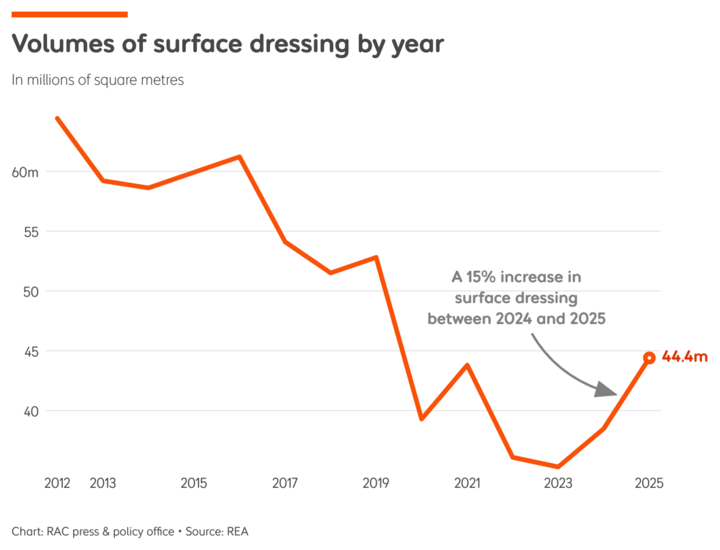New figures from the Road Emulsion Association (REA) have shown a 15% rise in the use of surface dressing this year, helping to reverse a decade-long decline in the use of the 'vital' preventative maintenance technique.
Surface dressing has been 'proven to prevent potholes forming' the REA said, stating that the latest numbers were 'encouraging' but with the caveat that the total amount of the pothole prevention work is still 32% below 2012 levels.
In 2023, surface dressing hit its lowest reported volume since records began in 1978. Since then things have started to turn around, with successive increases following concerted campaigning by the REA, the RAC and the Road Surface Treatments Association to get local authorities to understand the benefits of preventative maintenance.
This year the manufacturing, sale and use of bitumen emulsions for surface dressing was up 25% on 2023 (35.3 million square metres).
Around 44.4 million square metres of surface dressing – enough to treat around 4,340 miles of road – was applied over the April-to-September preventative maintenance season in 2025, compared to 38.5 million in 2024.

RAC head of policy Simon Williams said: 'These new figures are a step in the right direction for drivers who are plagued by potholes on Britain's roads every time they get behind the wheel. We welcome more local highway authorities carrying out surface dressing work, as this is proven to extend the life of roads by 10 to 15 years by sealing cracks and stopping water getting in and, ultimately, stopping surfaces breaking down.
'We hope even more surface dressing will be carried out going forwards as the Government is on board with the preventative maintenance message that the RAC, REA and the Road Surface Treatments Association have been advocating.
'We're also very pleased to see the Government asking councils to show how much preventative maintenance work they've carried out over the last five years and how much they plan to do in this financial year. We remain convinced that prevention, rather than cure, is the answer to smoother, safer roads.'
REA consultant and secretary Kevin Maw said: 'We reported a 9% increase in bitumen emulsion volumes in 2024 so to report a bigger increase for the second-year running is encouraging. We believe the surge in potholes over recent years directly correlates with the reduction in surface dressing – a successful preventative maintenance treatment that keeps roads in good condition.
'Investing in preventative highways maintenance is crucial to protecting one of the country's biggest assets and it's clear that this message is finally getting through. We hope it continues.'
Dorset Council principal project engineer Matthew Ings said: 'Dorset Council has long recognised the benefits of surface dressing as a cost-effective, low-carbon solution to extending the life of our highway network, reducing the need for frequent maintenance and minimising disruption to road users. With the recent addition of an encapsulation product, we've seen a marked improvement in public perception – thanks to a finished surface that closely resembles a conventionally surfaced road, with a clean, open, and positively textured appearance.'
Government road condition data analysed by the RAC shows half of local highway authorities in England did not use any form of preventative maintenance on their A roads in the 2023/24 financial year. For B, C and unclassified roads, 36% of authorities failed to carry out any of this work.
The same data illustrates a huge decline in the percentage of the overall road network receiving preventative treatments.

























